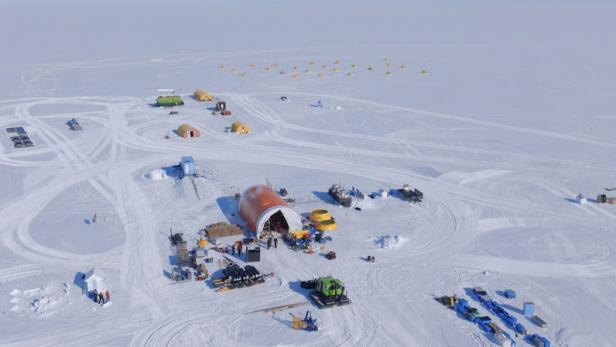

Forscher schmelzen a 580 meter deep Loch in Antarctic Eis
© Anthony Powell / Antarctica NZ
We are from the Zivilisatie-bohren Forscher through the thick Eisschicht in the Darrunterliegenden Ozean.
“Wir nutzen die Vergangenheit, um uns auf unsere Zukunft vorzubereiten.” With die Worten erklärt der deutsche Forscher Arne Ulfers das Vorhaben von 27 Wissenschaftlern. You camp during the Antarctic summer during the summer Ross-Schelfeisuhm the Klimawandel and dem View of the Meeresspiegel by the looks of it.
➤ Read more: Study: Eisschild in der Westantarktis schmilzt “unvermeidbar”
Drilling in warm water
Let it happen 580 meters Tiefes Loch in the Antarctic Eis, one of the most challenging Meerwasser vorzudringen. Dafür grifen die Forscher auf das sogenannte “Drilling in warm water“Zurück, bei dem das eis mithilfe von heißem Wasser geschmolzen wird.
I am of Ozean’s opinion that things have not gone so well yet. Soul is es, Sediment core from a tiefe von bis zu 200 meters could be won. The Antarctic Ozean lower end of the Ross-Schelfeis is uninterested 55 meters deep. I started Antarctica. Summer must come from the Vorhaben technical Gründen abgebrochen became.
➤ Read more: There was a secret American military base used by the Klimawandel
Research at the Steigenden Meeresspiegel
“Wir courts, we take the sediment from the lakes below the surface in Zeiträume bring it into the west Antarctic Eisschild heat and CO2 reicheren The war is expanding, which predicts for the coming years and years,” erklärt meeresgeologist Johann Klages by the Alfred-Wegener-Institut Bremerhaven.
“Damit could then answer the following questions: Who stabilizes the Western Antarctic requirements under these conditions and can we Kipppunkte identify, ab denen der Eisschildrückzug nicht mehr aufhaltbar ist?”, ergänzt Micropaläontologist Denise Kulhanek from the Christian-Albrechts-Universität in Kiel.
➤ Read more: Eisschmelze in der Arktis könnte Nordeuropa grim abkühlen
Beschwerliche Anreise zur Bohrstelle
Das Research- und Bohrcamp KIS3 ist Luftlinie 860 Kilometers weit von der nachstgelegenen Basis, der nueseeländischen Scott baseenfernt. Am 1. November has 6 Mitglieder der Camp-Besatzung on the country road in Richtung Bohrstelle.
If it’s okay Convoy aus Polarfahrzeugen transport the non-material treibstoff, the washing machine care, maintenance and preparation for the 8-week camp-saison over the years 1,128 kilometer long stretch. This journey is very simple 15 Tag dauern and the einsatz-eines Boden radars erfordern, der dabei hilft, tückische Gletscherspalten aufzuspüren.
If the Konvoi KIS3 is recommended, there is one Landebahn auf dem Eis für Flugzeuge with Skiing, the Bohrtruppe and the Wissenschaftler später a flight in November.